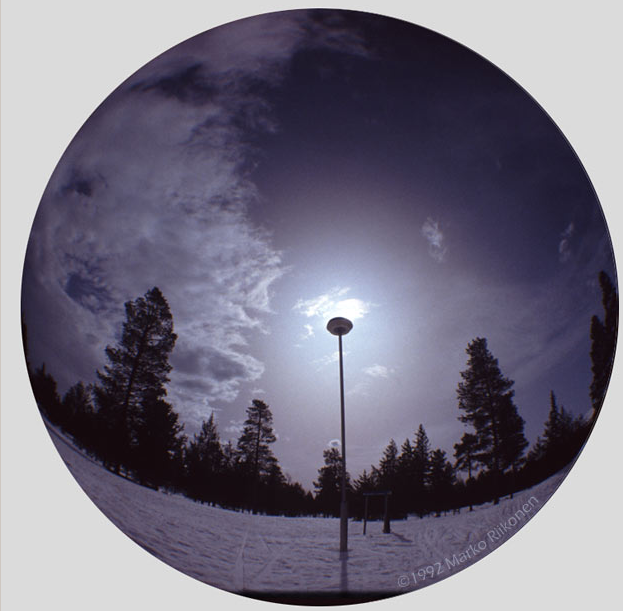Bishop's ring corona
The Beauty of Bishop's Ring Corona
When you look up at the sky during a particularly stunning sunrise or sunset, you may notice a captivating phenomenon surrounding the sun. A large and faint bluish aureole, edged by yellow and red hues, forms a beautiful ring around the sun. This optical effect is known as the "Bishop's ring corona." In this article, we will explore the mesmerizing intricacies of this atmospheric optics phenomenon and delve into its underlying causes.
The Bishop's ring corona is created through the scattering of sunlight by ash and hydrated sulfate droplets present in the stratosphere. These particles are a result of volcanic eruptions, such as the notable eruption of Mount Pinatubo in 1991. The eruption injected massive amounts of ash and aerosols into the atmosphere, leading to the formation of a unique corona-like effect.
What sets the Bishop's ring corona apart from other coronas is its distinct features, which arise from the narrow size range of the particles involved. These particles have a diameter of approximately 1µm (1/1000 mm). Due to their size, they scatter sunlight in a specific manner, resulting in the formation of the striking bluish aureole surrounded by yellow and red hues.
Here are some fascinating aspects to consider when observing the Bishop's ring corona:
-
Uniqueness: The Bishop's ring corona is a rare occurrence that is only visible under specific atmospheric conditions. It is not a regular feature of every sunrise or sunset, making it a remarkable sight to behold when it does appear.
-
Color Variations: The colors exhibited by the Bishop's ring corona can vary depending on various factors such as the composition of the particles, the angle of observation, and the atmospheric conditions. While bluish hues are often dominant, shades of yellow and red can also be observed.
-
Sunset and Sunrise Magic: The Bishop's ring corona is most commonly observed during sunrise or sunset when the sun is low on the horizon. The angle of the sunlight passing through the atmosphere plays a crucial role in creating this stunning optical phenomenon.
-
Volcanic Influence: The eruption of Mount Pinatubo in 1991 had a significant impact on the formation of the Bishop's ring corona. The ash and aerosols released during volcanic eruptions contribute to the scattering of sunlight, creating an atmosphere conducive to the appearance of this captivating optical effect.
-
Atmospheric Optics Research: The study of atmospheric optics, including phenomena like the Bishop's ring corona, provides valuable insights into the composition and behavior of particles in our atmosphere. Researchers use these observations to better understand the Earth's climate and atmospheric dynamics.
-
Photography Opportunities: Photographers and enthusiasts often capture the beauty of the Bishop's ring corona, showcasing its ethereal nature. These images not only serve as visual delights but also contribute to the documentation and understanding of this atmospheric phenomenon.
-
Similar Optical Effects: The Bishop's ring corona shares similarities with other atmospheric optics phenomena, such as halos and coronas. These optical effects are all caused by the scattering and diffraction of sunlight by particles in the atmosphere, leading to the creation of stunning visual displays.
-
Global Impact: The presence of the Bishop's ring corona following volcanic eruptions highlights the far-reaching consequences of these natural events. Volcanic activity can have significant effects on weather patterns, air quality, and even global temperatures, underscoring the interconnectedness of Earth's systems.
-
Scientific Collaboration: The study of the Bishop's ring corona requires collaboration among scientists, meteorologists, and atmospheric physicists. By combining expertise from various fields, researchers can gain a comprehensive understanding of this unique optical phenomenon and its implications for our planet.
-
Appreciating Nature's Wonders: The Bishop's ring corona serves as a reminder of the immense beauty and complexity of our natural world. By taking the time to observe and appreciate these awe-inspiring atmospheric optics phenomena, we can develop a deeper connection with our environment and foster a sense of wonder for the world around us.
In conclusion, the Bishop's ring corona is a captivating atmospheric optics phenomenon that enchants observers with its unique beauty. Formed by the scattering of sunlight by particles in the stratosphere, this corona-like effect exhibits distinct features, colors, and associations with volcanic activity. By studying and appreciating these natural wonders, we gain a greater understanding of our planet's intricate atmospheric dynamics and the interconnectedness of Earth's systems. So, next time you witness a breathtaking sunrise or sunset, keep an eye out for the mesmerizing Bishop's ring corona, and allow yourself to be captivated by its ethereal charm.

Bishop's ring imaged by Marko Riikonen (site) at Vuontisjarvi, Finland on 1st May 1992. Image ©Marko Riikonen, shown with permission.
A large and faint bluish aureole edged by a yellow and red surrounds the sun . This is a "Bishop's ring".
This corona like effect is produced by the scattering of sunlight by ash and hydrated sulfate droplets in the stratosphere resulting from the eruption of Mount Pinatubo in 1991. The particular features of the Bishop's ring arise from the narrow size range of the particles which are about 1µm (1/1000 mm) in diameter.
More Bishop's rings 1,2.
Sunsets and volcanic ash.
Note: this article has been automatically converted from the old site and may not appear as intended. You can find the original article here.
Reference Atmospheric Optics
If you use any of the definitions, information, or data presented on Atmospheric Optics, please copy the link or reference below to properly credit us as the reference source. Thank you!
-
<a href="https://atoptics.co.uk/blog/bishops-ring-corona/">Bishop's ring corona</a>
-
"Bishop's ring corona". Atmospheric Optics. Accessed on December 21, 2024. https://atoptics.co.uk/blog/bishops-ring-corona/.
-
"Bishop's ring corona". Atmospheric Optics, https://atoptics.co.uk/blog/bishops-ring-corona/. Accessed 21 December, 2024
-
Bishop's ring corona. Atmospheric Optics. Retrieved from https://atoptics.co.uk/blog/bishops-ring-corona/.